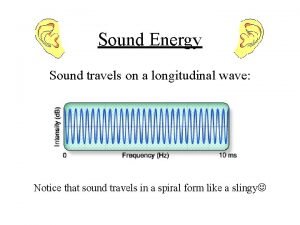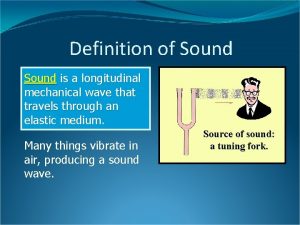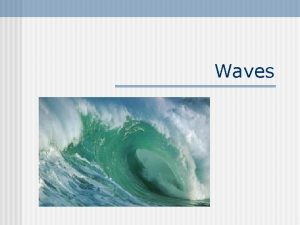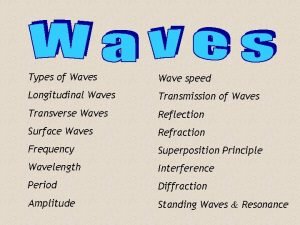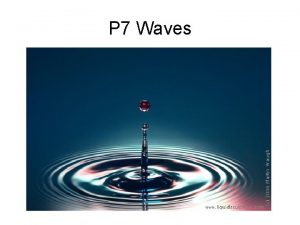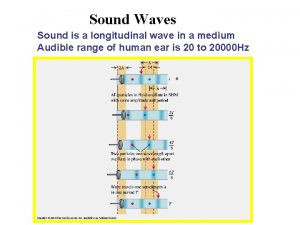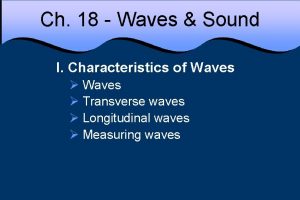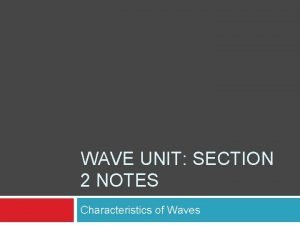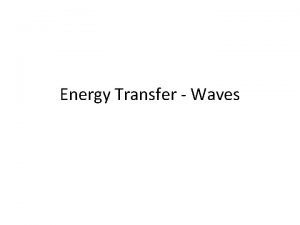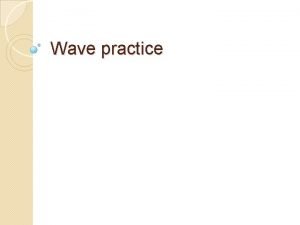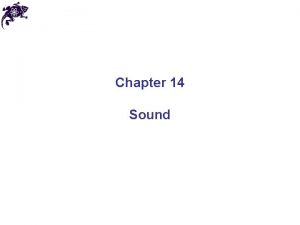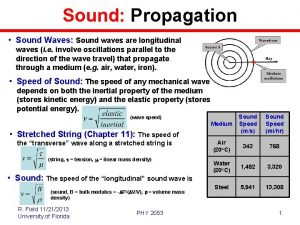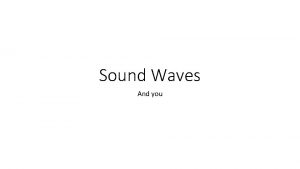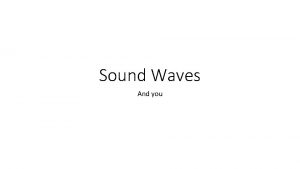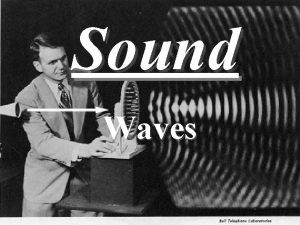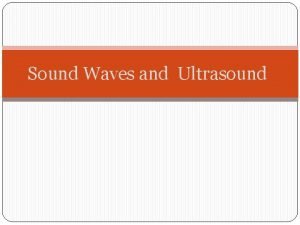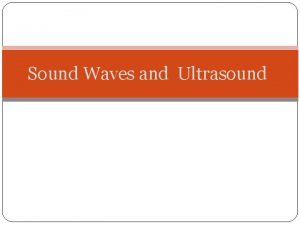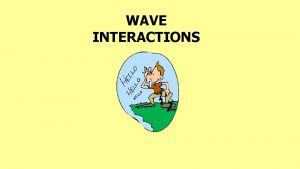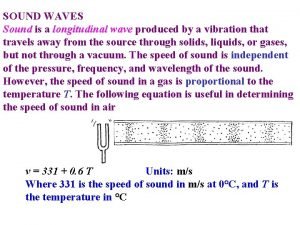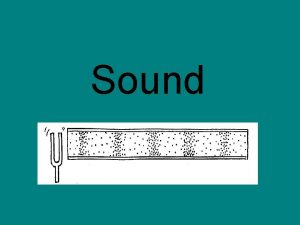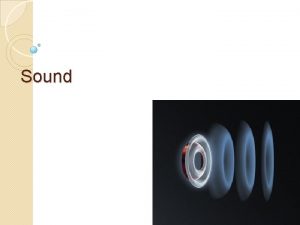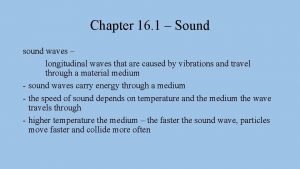Wave practice Longitudinal all sound waves are longitudinal


























- Slides: 26

Wave practice

Longitudinal: all sound waves are longitudinal Longitudinal: waves that have compressions and rarefactions are longitud

Transversal: perpendicular (up and down) displacement. Longitudinal: waves that have compressions and rarefactions are longitudinal

Transversal: perpendicular (up and down) displacement.

Transversal: perpendicular (up and down displacement.

1. Draw a wave diagram and show the following: amplitude of 5 meters and a wavelength of 10 meters. 5 m 5 m 10 m

2. Determine the period of a wave that has a frequency to 14 hertz. T = 1/f T = 1/14 seconds T = 0. 0714 seconds

3. Determine the frequency that has a period of 4 seconds. f = 1/T f = ¼ Hz f = 0. 25 Hz

4. 4. 16 m 10 m 4 m 5 m 15 m 25 m Determine the wavelength and the amplitude of the wave. Amplitude: 6 m wavelength: 20 m

5. Knowing that the velocity of a wave is determined by the equation v = f l, a. calculate the velocity if the wave has a frequency of 12 Hz and a wavelength of 3 meters. b. calculate the frequency if the velocity is 8 m/s and the wavelength is 4 meters. c. calculate the wave length if the frequency is 16 hertz and the velocity is 8 m/s. d. calculate the velocity of the wave if the period of the wave is 2 seconds and the wave length is 4 meters.

a. calculate the velocity if the wave has a frequency of 12 Hz and a wavelength of 3 meters. v=fl v = 12 x 3 = 36 m/s

b. calculate the frequency if the velocity is 8 m/s and the wavelength is 4 meters. v=fl 8 = f (4) f = 2 Hz

c. calculate the wave length if the frequency is 16 hertz and the velocity is 8 m/s. v=fl 8 = 16 l l = 0. 5 m

d. calculate the velocity of the wave if the period of the wave is 2 seconds and the wave length is 4 meters. v=fl v = 1/T l v = ½ (4) v = 2 m/s

6. A B Explain which of the two waves has a higher frequency. Wave B has a higher frequency because it has a shorter wavelength.

1. A wave is traveling in a rope. The diagram below represents a snapshot of the rope at a particular instant in time. Determine the number of wavelengths which is equal to the horizontal distance between points: a. C and E 1 b. C and K 3. 5 c. A and J 4 d. B and F 1. 5 e. D and H 2 f. E and I 1. 75

2. Illustrate, by drawing figures: (use different colors or solid vs. dotted, etc. ) 1. two waves of the same amplitude but different wavelengths 2. two waves of the same wavelength but different amplitudes

3. As the pitch of a sound wave increases, what happens to the wavelength? Why? Increase pitch increase frequency Increase frequency decrease wavelength Sound travel at the same speed in the same medium and using the equation v = f l, we can see that wavelength and frequency have an inverse relationship. As one increases, the other decreases.

4. How would you find the frequency of the sound wave produced by a speaker which vibrates at a rate of 660 cycles per second? The frequency of the wave is always the same as the frequency of the source that produces that wave, therefore the frequency of the sound is 660 Hz.

5. Calculate the wavelength for the sound wave in question 4. v=fl l=v/f l = 340/660 = 0. 52 m

6. Extreme waves along ocean waters are sometimes referred to as rogue waves. Merchant ships have reported rogue waves which are estimated to be 25 m high and 26 m long. Assuming that these waves travel at 6. 5 m/s, determine the frequency and period of these waves. v=fl f=v/l f = 6. 5 / 26 = 0. 25 Hz T = 1/f = 1/0. 25 = 4 seconds

7. Susie is listening to her favorite radio station - 102. 3 FM. The station broadcasts radio signals with a frequency of 1. 023 x 108 Hz. The radio wave signal travel through the air at a speed of 3. 0 x 108 m/s. Determine the wavelength of these radio waves. v=fl l=v/f = 3. 0 x 108 / 1. 023 x 108 = 2. 93 m

8. A transverse wave is observed to be moving along a lengthy rope. Adjacent crests are positioned 2. 4 m apart. Exactly six crests are observed to move past a given point along the medium in 9. 1 seconds. Determine the wavelength, frequency and speed of these waves. 1 wave = 2. 4 meters = wavelength frequency = 6 waves / 9. 1 seconds = 0. 66 Hz velocity = 0. 66 x 2. 4 = 1. 58 m/s

9. A marine weather station detects waves which are 9. 28 m long and 1. 65 m high that travel a distance of 50. 0 m in 21. 8 s. Calculate the velocity and frequency of the waves. wavelength = 9. 28 m frequency = how many wave in 50 m / 21. 8 seconds = (50 / 9. 28) / 21. 8 = 0. 247 Hz velocity = 0. 247 * 9. 28 = 2. 29 m/s


 Sound waves longitudinal waves
Sound waves longitudinal waves Light is electromagnetic radiation true or false
Light is electromagnetic radiation true or false Mikael ferm
Mikael ferm Compare and contrast transverse and longitudinal waves
Compare and contrast transverse and longitudinal waves Velocity frequency wavelength triangle
Velocity frequency wavelength triangle How sound travel
How sound travel Sound is a longitudinal mechanical wave
Sound is a longitudinal mechanical wave Difference between electromagnetic waves and sound waves
Difference between electromagnetic waves and sound waves Characteristics of a longitudinal wave
Characteristics of a longitudinal wave Compare and contrast transverse and longitudinal waves
Compare and contrast transverse and longitudinal waves Transverse vs longitudinal waves
Transverse vs longitudinal waves List of waves
List of waves What type of wave is shown below?
What type of wave is shown below? Rarefaction of a wave
Rarefaction of a wave Whats a longitudinal wave
Whats a longitudinal wave What waves don't require a medium
What waves don't require a medium Low amplitude wave
Low amplitude wave Nature of sound wave
Nature of sound wave Wave unit
Wave unit Longitudinal wave energy transfer
Longitudinal wave energy transfer Longitudinal wave
Longitudinal wave Mechanical and electromagnetic waves
Mechanical and electromagnetic waves Long waves and short waves
Long waves and short waves Mechanical waves and electromagnetic waves similarities
Mechanical waves and electromagnetic waves similarities Mechanical waves vs electromagnetic waves
Mechanical waves vs electromagnetic waves Mechanical waves and electromagnetic waves similarities
Mechanical waves and electromagnetic waves similarities Surface waves and body waves
Surface waves and body waves





